Immortalization of Mesenchymal Stem Cell Lines from Sheep Umbilical Cord Tissue
Abstract
Simple Summary
Abstract
1. Introduction
2. Materials and Methods
2.1. Ethic Statement
2.2. Animals
2.3. Stem Cell Isolation and Culture Expansion
2.4. TERT Cotransfection
2.5. Infection and Screening
2.6. Surface Marker Expression Analysis
2.7. β-Galactosidase Activity Assay
2.8. Quantitative PCR
2.9. Growth Kinetics and Population Doubling Time (PDT)
2.10. EdU-Azide 488 and Hoechst 33342/PI Staining
2.11. Tri-Lineage Differentiation
2.11.1. Osteogenic Differentiation
2.11.2. Adipogenic Differentiation
2.11.3. Chondrogenic Differentiation
2.12. Soft Agar Colony Formation
2.13. Statistics Analysis
3. Results
3.1. Umbilical Cord Tissue Isolation and Culture Expansion
3.2. Screening
3.3. Phenotypic Gene Expression
3.4. β-Galactosidase Activity Assay
3.5. TERT Expression
3.6. Growth Kinetics and PDT
3.7. EdU-Azide 488 and Hoechst 33342/PI Staining
3.8. Osteogenic, Lipogenic, and Chondrogenic Differentiation
3.9. Soft Agar Tumorigenicity Test
4. Discussion
5. Conclusions
Supplementary Materials
Author Contributions
Funding
Institutional Review Board Statement
Informed Consent Statement
Data Availability Statement
Acknowledgments
Conflicts of Interest
Abbreviations
References
- Steens, J.; Klein, D. Current Strategies to Generate Human Mesenchymal Stem Cells In Vitro. Stem Cells Int. 2018, 2018, e6726185. [Google Scholar] [CrossRef]
- Owen, M.; Friedenstein, A.J. Stromal Stem Cells: Marrow-Derived Osteogenic Precursors. Ciba Found. Symp. 1988, 136, 42–60. [Google Scholar] [CrossRef]
- Ashton, B.A.; Allen, T.D.; Howlett, C.R.; Eaglesom, C.C.; Hattori, A.; Owen, M. Formation of Bone and Cartilage by Marrow Stromal Cells in Diffusion Chambers In Vivo. Clin. Orthop. Relat. Res. 1980, 151, 294–307. [Google Scholar] [CrossRef]
- Jo, H.; Brito, S.; Kwak, B.M.; Park, S.; Lee, M.-G.; Bin, B.-H. Applications of Mesenchymal Stem Cells in Skin Regeneration and Rejuvenation. Int. J. Mol. Sci. 2021, 22, 2410. [Google Scholar] [CrossRef]
- Hoang, D.M.; Pham, P.T.; Bach, T.Q.; Ngo, A.T.L.; Phan, T.T.K.; Nguyen, G.H.; Le, P.T.T.; Hoang, V.T.; Forsyth, N.R.; Heke, M.; et al. Stem Cell-Based Therapy for Human Diseases. Signal Transduct. Target. Ther. 2022, 7, 272. [Google Scholar] [CrossRef]
- Yang, J.; Zhang, Y.S.; Yue, K.; Khademhosseini, A. Cell-Laden Hydrogels for Osteochondral and Cartilage Tissue Engineering. Acta Biomater. 2017, 57, 1–25. [Google Scholar] [CrossRef]
- Baghaei, K.; Hashemi, S.M.; Tokhanbigli, S.; Asadi Rad, A.; Assadzadeh-Aghdaei, H.; Sharifian, A.; Zali, M.R. Isolation, Differentiation, and Characterization of Mesenchymal Stem Cells from Human Bone Marrow. Gastroenterol. Hepatol. Bed Bench 2017, 10, 208–213. [Google Scholar]
- Trivanović, D.; Kocić, J.; Mojsilović, S.; Krstić, A.; Ilić, V.; Djordjević, I.O.; Santibanez, J.F.; Jovcić, G.; Terzić, M.; Bugarski, D. Mesenchymal Stem Cells Isolated from Peripheral Blood and Umbilical Cord Wharton’s Jelly. Srp. Arh. Celok. Lek. 2013, 141, 178–186. [Google Scholar] [CrossRef]
- Zeddou, M.; Briquet, A.; Relic, B.; Josse, C.; Malaise, M.G.; Gothot, A.; Lechanteur, C.; Beguin, Y. The Umbilical Cord Matrix Is a Better Source of Mesenchymal Stem Cells (MSC) than the Umbilical Cord Blood. Cell Biol. Int. 2010, 34, 693–701. [Google Scholar] [CrossRef]
- Megaloikonomos, P.D.; Panagopoulos, G.N.; Bami, M.; Igoumenou, V.G.; Dimopoulos, L.; Milonaki, A.; Kyriakidou, M.; Mitsiokapa, E.; Anastassopoulou, J.; Mavrogenis, A.F. Harvesting, Isolation and Differentiation of Rat Adipose-Derived Stem Cells. Curr. Pharm. Biotechnol. 2018, 19, 19–29. [Google Scholar] [CrossRef]
- Sanberg, P.R.; Eve, D.J.; Willing, A.E.; Garbuzova-Davis, S.; Tan, J.; Sanberg, C.D.; Allickson, J.G.; Cruz, L.E.; Borlongan, C.V. The Treatment of Neurodegenerative Disorders Using Umbilical Cord Blood and Menstrual Blood-Derived Stem Cells. Cell Transplant. 2011, 20, 85–94. [Google Scholar] [CrossRef]
- Kadiyala, S.; Young, R.G.; Thiede, M.A.; Bruder, S.P. Culture Expanded Canine Mesenchymal Stem Cells Possess Osteochondrogenic Potential in Vivo and in Vitro. Cell Transpl. 1997, 6, 125–134. [Google Scholar] [CrossRef]
- Friedenstein, A.J.; Gorskaja, J.F.; Kulagina, N.N. Fibroblast Precursors in Normal and Irradiated Mouse Hematopoietic Organs. Exp. Hematol. 1976, 4, 267–274. [Google Scholar]
- Wang, P.; Zhang, S.; Meng, Q.; Zhu, P.; Yuan, W. Treatment and Application of Stem Cells from Different Sources for Cartilage Injury: A Literature Review. Ann. Transl. Med. 2022, 10, 610. [Google Scholar] [CrossRef]
- Liang, H.; Suo, H.; Wang, Z.; Feng, W. Progress in the Treatment of Osteoarthritis with Umbilical Cord Stem Cells. Hum. Cell 2020, 33, 470–475. [Google Scholar] [CrossRef]
- Satheesan, L.; Soundian, E.; Kumanan, V.; Kathaperumal, K. Potential of Ovine Wharton Jelly Derived Mesenchymal Stem Cells to Transdifferentiate into Neuronal Phenotype for Application in Neuroregenerative Therapy. Int. J. Neurosci. 2020, 130, 1101–1108. [Google Scholar] [CrossRef]
- Al-Ghadban, S.; Bunnell, B.A. Adipose Tissue-Derived Stem Cells: Immunomodulatory Effects and Therapeutic Potential. Physiology 2020, 35, 125–133. [Google Scholar] [CrossRef]
- Wang, L.-T.; Liu, K.-J.; Sytwu, H.-K.; Yen, M.-L.; Yen, B.L. Advances in Mesenchymal Stem Cell Therapy for Immune and Inflammatory Diseases: Use of Cell-Free Products and Human Pluripotent Stem Cell-Derived Mesenchymal Stem Cells. Stem Cells Transl. Med. 2021, 10, 1288–1303. [Google Scholar] [CrossRef]
- Behr, L.; Hekmati, M.; Fromont, G.; Borenstein, N.; Noel, L.-H.; Lelievre-Pegorier, M.; Laborde, K. Intra Renal Arterial Injection of Autologous Mesenchymal Stem Cells in an Ovine Model in the Postischemic Kidney. Nephron Physiol. 2007, 107, p65–p76. [Google Scholar] [CrossRef]
- Shu, C.C.; Dart, A.; Bell, R.; Dart, C.; Clarke, E.; Smith, M.M.; Little, C.B.; Melrose, J. Efficacy of Administered Mesenchymal Stem Cells in the Initiation and Co-Ordination of Repair Processes by Resident Disc Cells in an Ovine (Ovis Aries) Large Destabilizing Lesion Model of Experimental Disc Degeneration. JOR Spine 2018, 1, e1037. [Google Scholar] [CrossRef]
- Al Faqeh, H.; Nor Hamdan, B.M.Y.; Chen, H.C.; Aminuddin, B.S.; Ruszymah, B.H.I. The Potential of Intra-Articular Injection of Chondrogenic-Induced Bone Marrow Stem Cells to Retard the Progression of Osteoarthritis in a Sheep Model. Exp. Gerontol. 2012, 47, 458–464. [Google Scholar] [CrossRef] [PubMed]
- Horikawa, I.; Barrett, J.C. Transcriptional Regulation of the Telomerase hTERT Gene as a Target for Cellular and Viral Oncogenic Mechanisms. Carcinogenesis 2003, 24, 1167–1176. [Google Scholar] [CrossRef]
- Shu, Y.; Yang, C.; Ji, X.; Zhang, L.; Bi, Y.; Yang, K.; Gong, M.; Liu, X.; Guo, Q.; Su, Y.; et al. Reversibly Immortalized Human Umbilical Cord-Derived Mesenchymal Stem Cells (UC-MSCs) Are Responsive to BMP9-Induced Osteogenic and Adipogenic Differentiation. J. Cell Biochem. 2018, 119, 8872–8886. [Google Scholar] [CrossRef]
- Liang, X.-J.; Chen, X.-J.; Yang, D.-H.; Huang, S.-M.; Sun, G.-D.; Chen, Y.-P. Differentiation of Human Umbilical Cord Mesenchymal Stem Cells into Hepatocyte-like Cells by hTERT Gene Transfection In Vitro. Cell Biol. Int. 2012, 36, 215–221. [Google Scholar] [CrossRef] [PubMed]
- Pino-Barrio, M.J.; García-García, E.; Menéndez, P.; Martínez-Serrano, A. V-Myc Immortalizes Human Neural Stem Cells in the Absence of Pluripotency-Associated Traits. PLoS ONE 2015, 10, e0118499. [Google Scholar] [CrossRef]
- Kim, N.W.; Piatyszek, M.A.; Prowse, K.R.; Harley, C.B.; West, M.D.; Ho, P.L.; Coviello, G.M.; Wright, W.E.; Weinrich, S.L.; Shay, J.W. Specific Association of Human Telomerase Activity with Immortal Cells and Cancer. Science 1994, 266, 2011–2015. [Google Scholar] [CrossRef] [PubMed]
- Kelland, L.R. Overcoming the Immortality of Tumour Cells by Telomere and Telomerase Based Cancer Therapeutics--Current Status and Future Prospects. Eur. J. Cancer 2005, 41, 971–979. [Google Scholar] [CrossRef]
- Al Zouabi, L.; Bardin, A.J. Stem Cell DNA Damage and Genome Mutation in the Context of Aging and Cancer Initiation. Cold Spring Harb. Perspect. Biol. 2020, 12, a036210. [Google Scholar] [CrossRef]
- Solomon, E.; Borrow, J.; Goddard, A.D. Chromosome Aberrations and Cancer. Science 1991, 254, 1153–1160. [Google Scholar] [CrossRef]
- Ilango, S.; Paital, B.; Jayachandran, P.; Padma, P.R.; Nirmaladevi, R. Epigenetic Alterations in Cancer. Front. Biosci. (Landmark Ed) 2020, 25, 1058–1109. [Google Scholar] [CrossRef]
- Dratwa, M.; Wysoczańska, B.; Łacina, P.; Kubik, T.; Bogunia-Kubik, K. TERT-Regulation and Roles in Cancer Formation. Front. Immunol. 2020, 11, 589929. [Google Scholar] [CrossRef] [PubMed]
- Dominici, M.; Le Blanc, K.; Mueller, I.; Slaper-Cortenbach, I.; Marini, F.; Krause, D.; Deans, R.; Keating, A.; Prockop, D.; Horwitz, E. Minimal Criteria for Defining Multipotent Mesenchymal Stromal Cells. The International Society for Cellular Therapy Position Statement. Cytotherapy 2006, 8, 315–317. [Google Scholar] [CrossRef] [PubMed]
- Li, Y.; Wu, Q.; Wang, Y.; Li, L.; Bu, H.; Bao, J. Senescence of Mesenchymal Stem Cells (Review). Int. J. Mol. Med. 2017, 39, 775–782. [Google Scholar] [CrossRef] [PubMed]
- Wang, L.; Song, K.; Qu, X.; Wang, H.; Zhu, H.; Xu, X.; Zhang, M.; Tang, Y.; Yang, X. hTERT Gene Immortalized Human Adipose-Derived Stem Cells and Its Multiple Differentiations: A Preliminary Investigation. Appl. Biochem. Biotechnol. 2013, 169, 1546–1556. [Google Scholar] [CrossRef] [PubMed]
- Reiter, S.; Gärtner, S.; Decker, K.; Pöhlmann, S.; Winkler, M. Development of Immortalized Rhesus Macaque Kidney Cells Supporting Infection with a Panel of Viruses. PLoS ONE 2023, 18, e0284048. [Google Scholar] [CrossRef] [PubMed]
- Steele, S.L.; Wu, Y.; Kolb, R.J.; Gooz, M.; Haycraft, C.J.; Keyser, K.T.; Guay-Woodford, L.; Yao, H.; Bell, P.D. Telomerase Immortalization of Principal Cells from Mouse Collecting Duct. Am. J. Physiol. Ren. Physiol. 2010, 299, F1507–F1514. [Google Scholar] [CrossRef] [PubMed]
- Yin, Z.; Wang, Q.; Li, Y.; Wei, H.; Shi, J.; Li, A. A Novel Method for Banking Stem Cells from Human Exfoliated Deciduous Teeth: Lentiviral TERT Immortalization and Phenotypical Analysis. Stem Cell Res. Ther. 2016, 7, 50. [Google Scholar] [CrossRef]
- Kim, T.K.; Eberwine, J.H. Mammalian Cell Transfection: The Present and the Future. Anal. Bioanal. Chem. 2010, 397, 3173–3178. [Google Scholar] [CrossRef]
- Potter, H.; Heller, R. Transfection by Electroporation. Curr. Protoc. Mol. Biol. 2018, 121, 9.3.1–9.3.13. [Google Scholar] [CrossRef]
- Alcorn, J.L.; Smith, M.E.; Smith, J.F.; Margraf, L.R.; Mendelson, C.R. Primary Cell Culture of Human Type II Pneumonocytes: Maintenance of a Differentiated Phenotype and Transfection with Recombinant Adenoviruses. Am. J. Respir. Cell Mol. Biol. 1997, 17, 672–682. [Google Scholar] [CrossRef]
- Lu, W.; Zhang, Y.; Liu, D.; Songyang, Z.; Wan, M. Telomeres-Structure, Function, and Regulation. Exp. Cell Res. 2013, 319, 133–141. [Google Scholar] [CrossRef] [PubMed]
- Levine, B.L.; Humeau, L.M.; Boyer, J.; MacGregor, R.-R.; Rebello, T.; Lu, X.; Binder, G.K.; Slepushkin, V.; Lemiale, F.; Mascola, J.R.; et al. Gene Transfer in Humans Using a Conditionally Replicating Lentiviral Vector. Proc. Natl. Acad. Sci. USA 2006, 103, 17372–17377. [Google Scholar] [CrossRef] [PubMed]
- Fan, H.; Johnson, C. Insertional Oncogenesis by Non-Acute Retroviruses: Implications for Gene Therapy. Viruses 2011, 3, 398–422. [Google Scholar] [CrossRef] [PubMed]
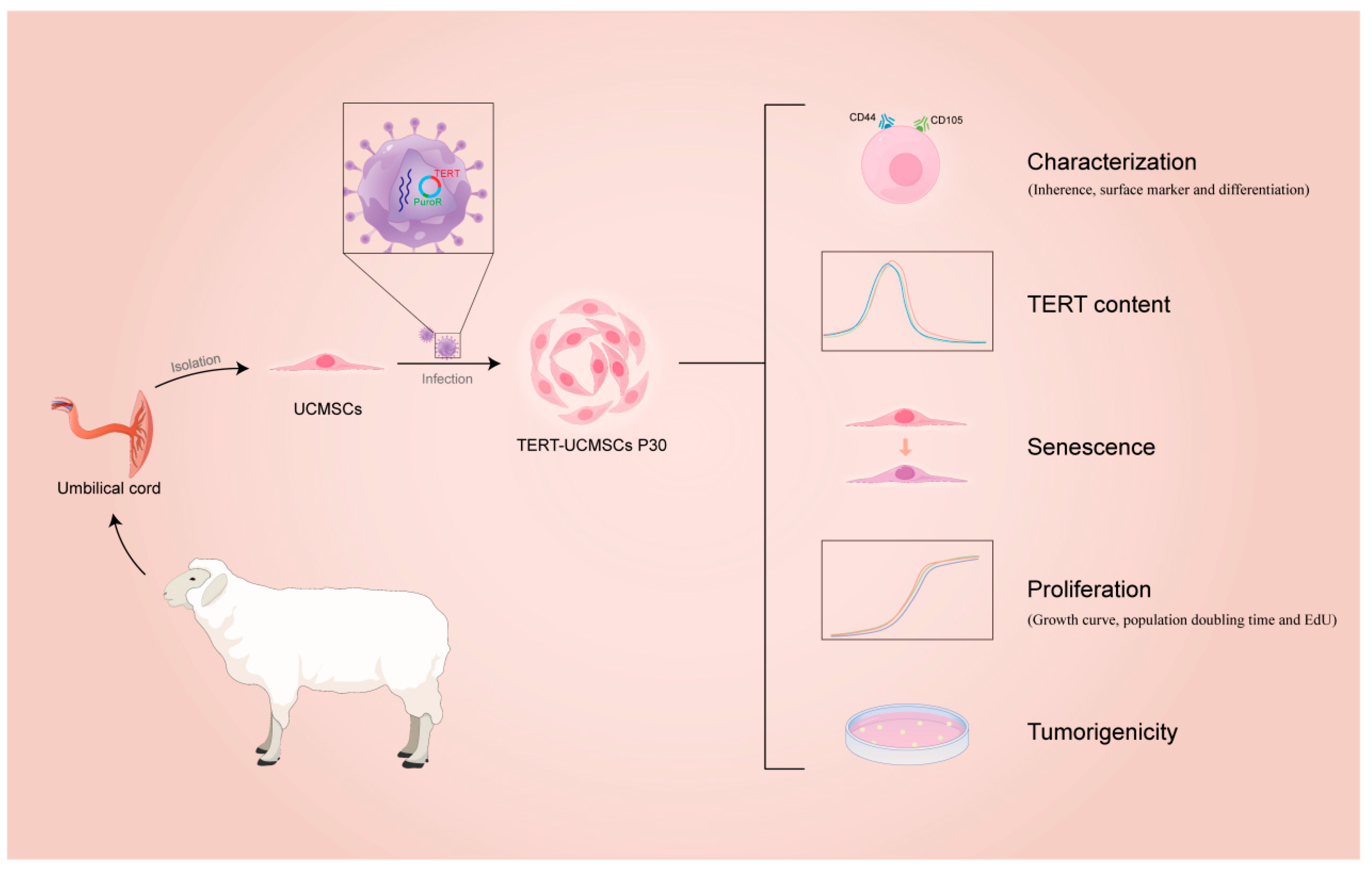
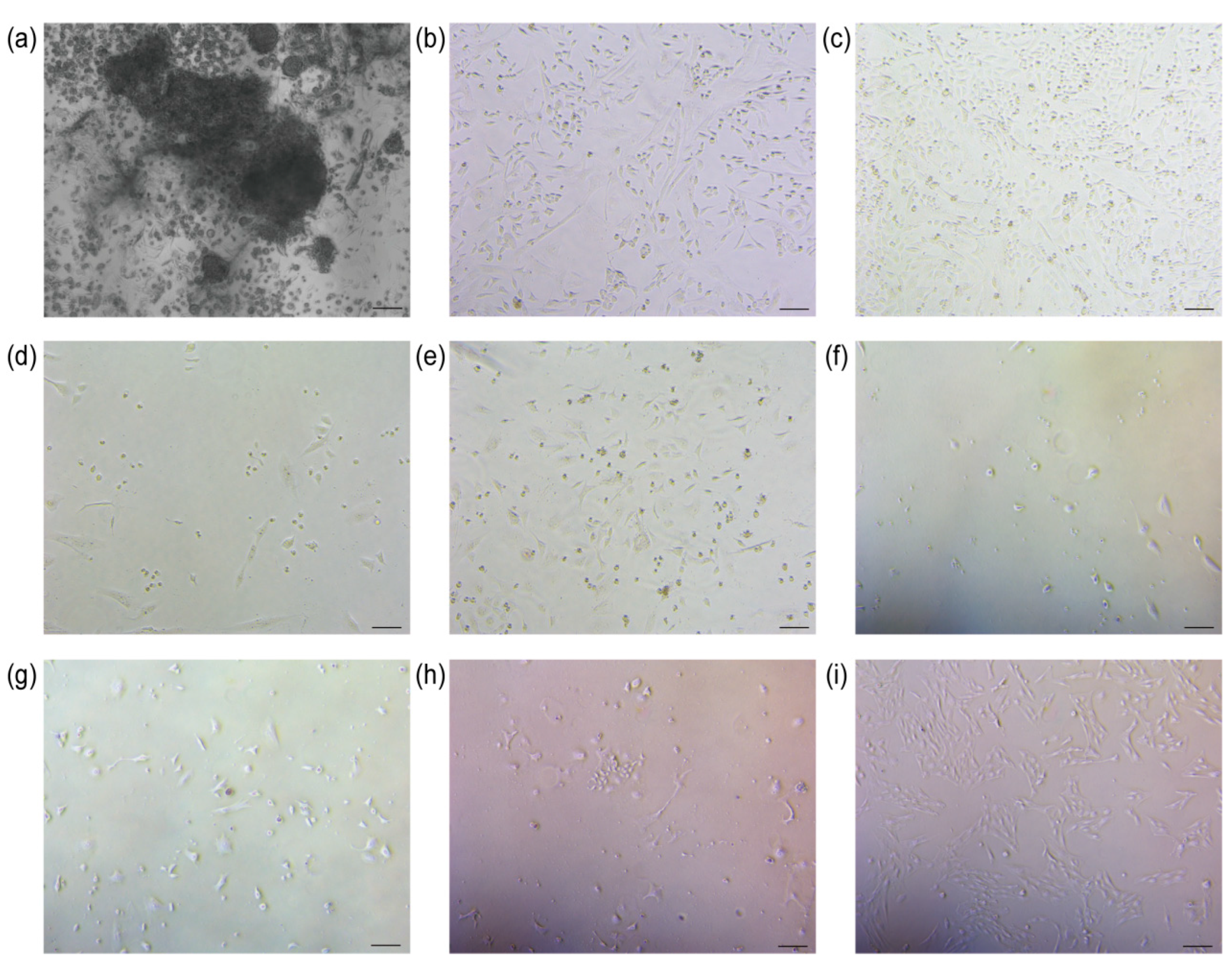
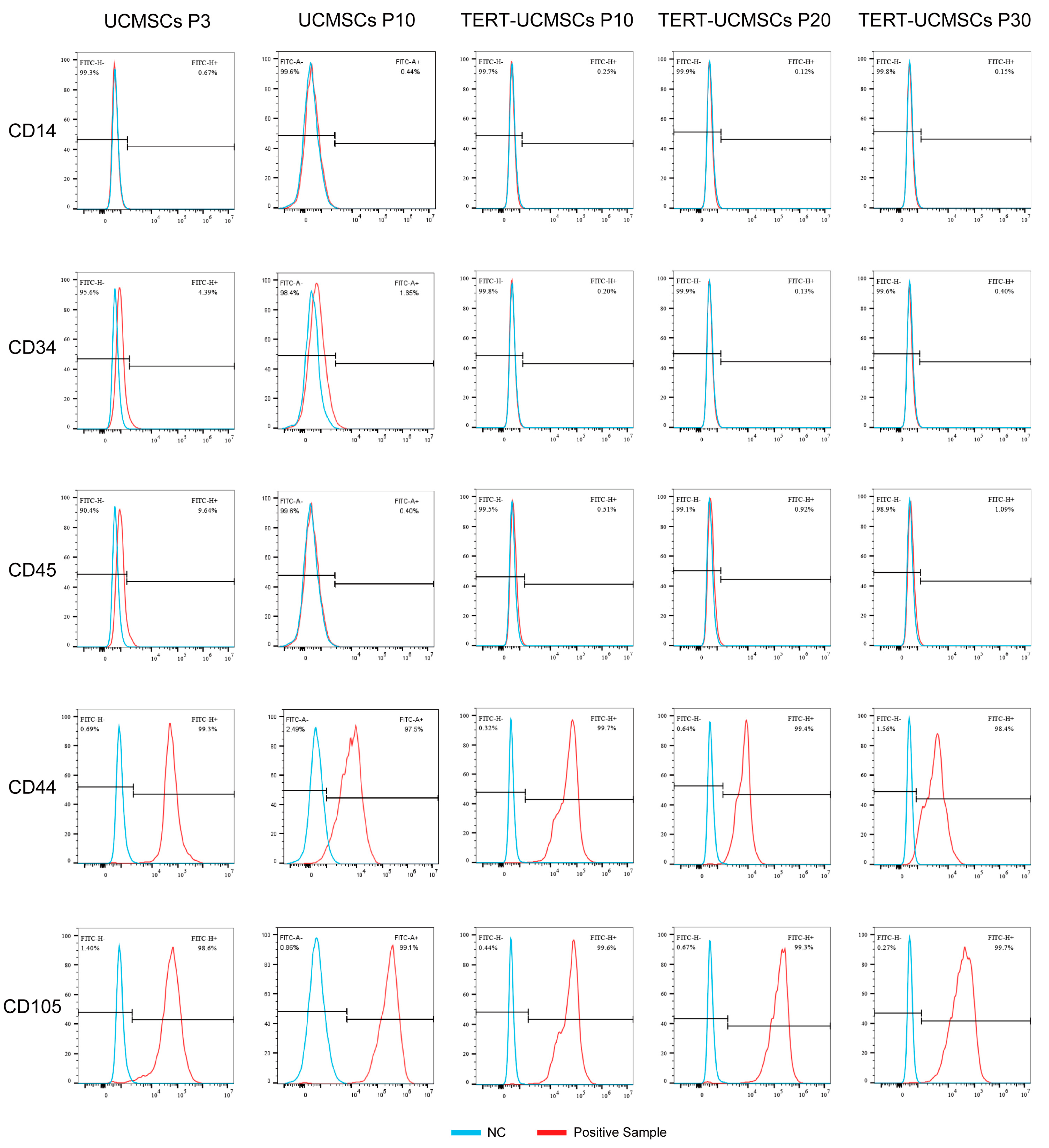
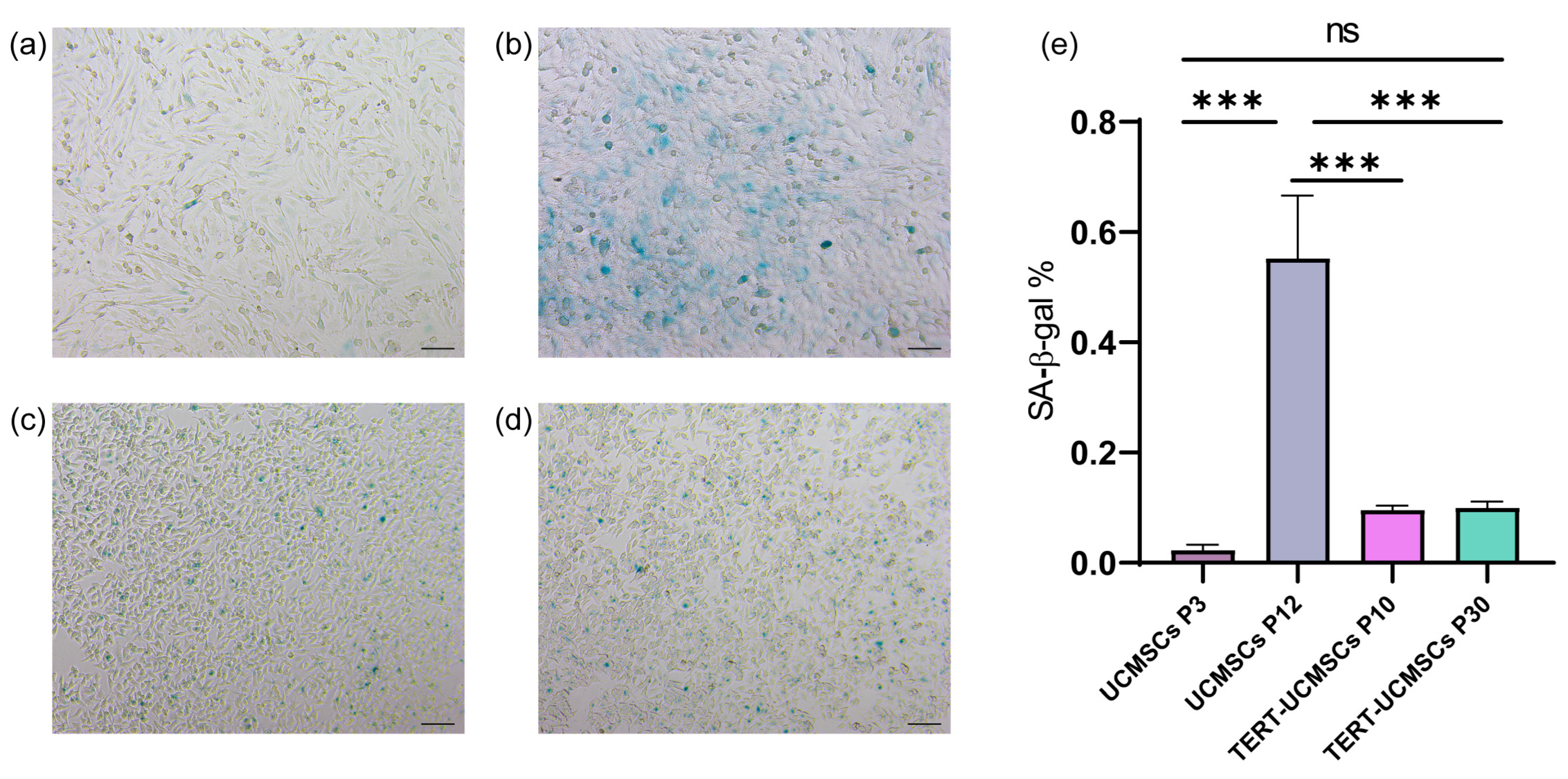

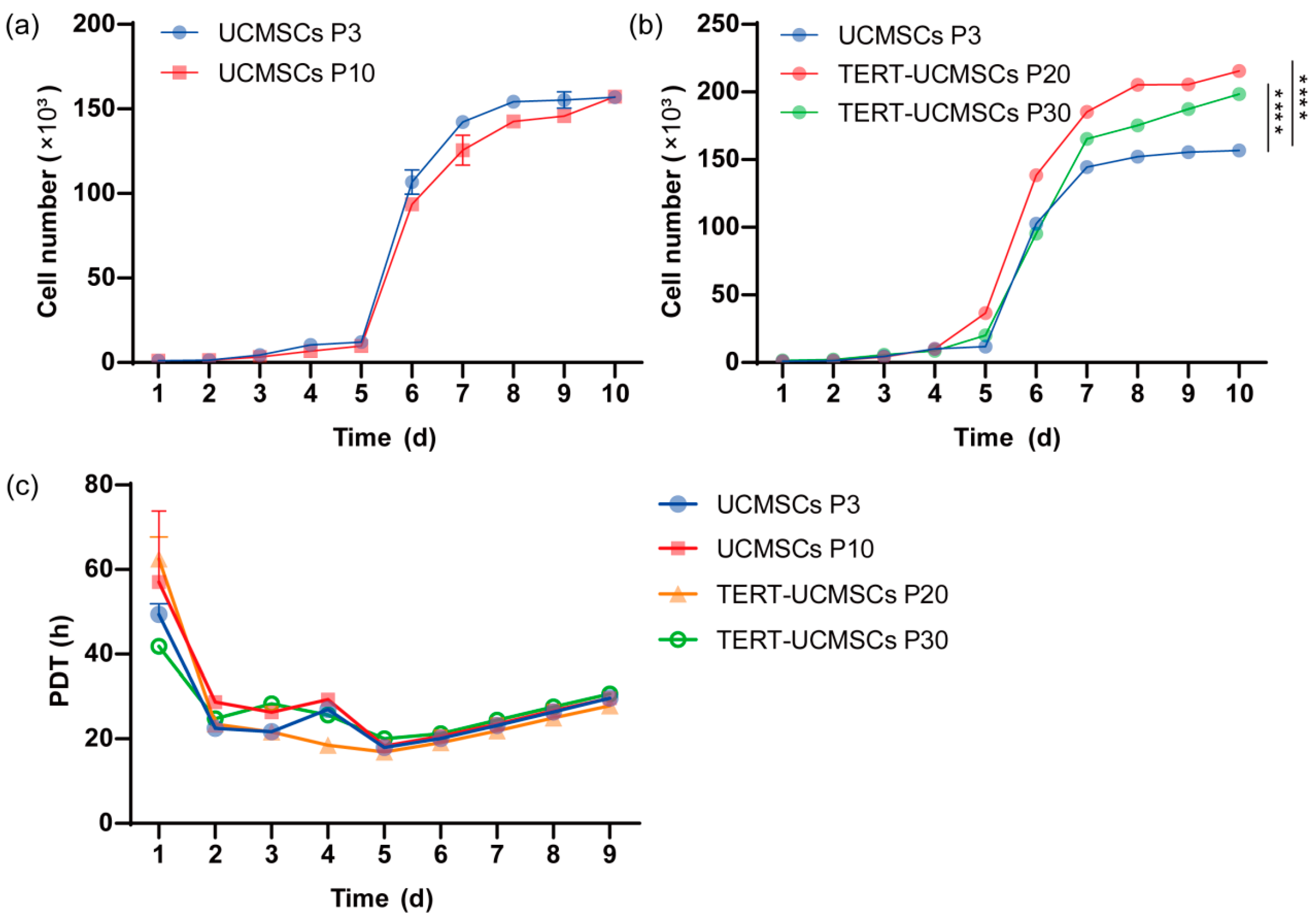
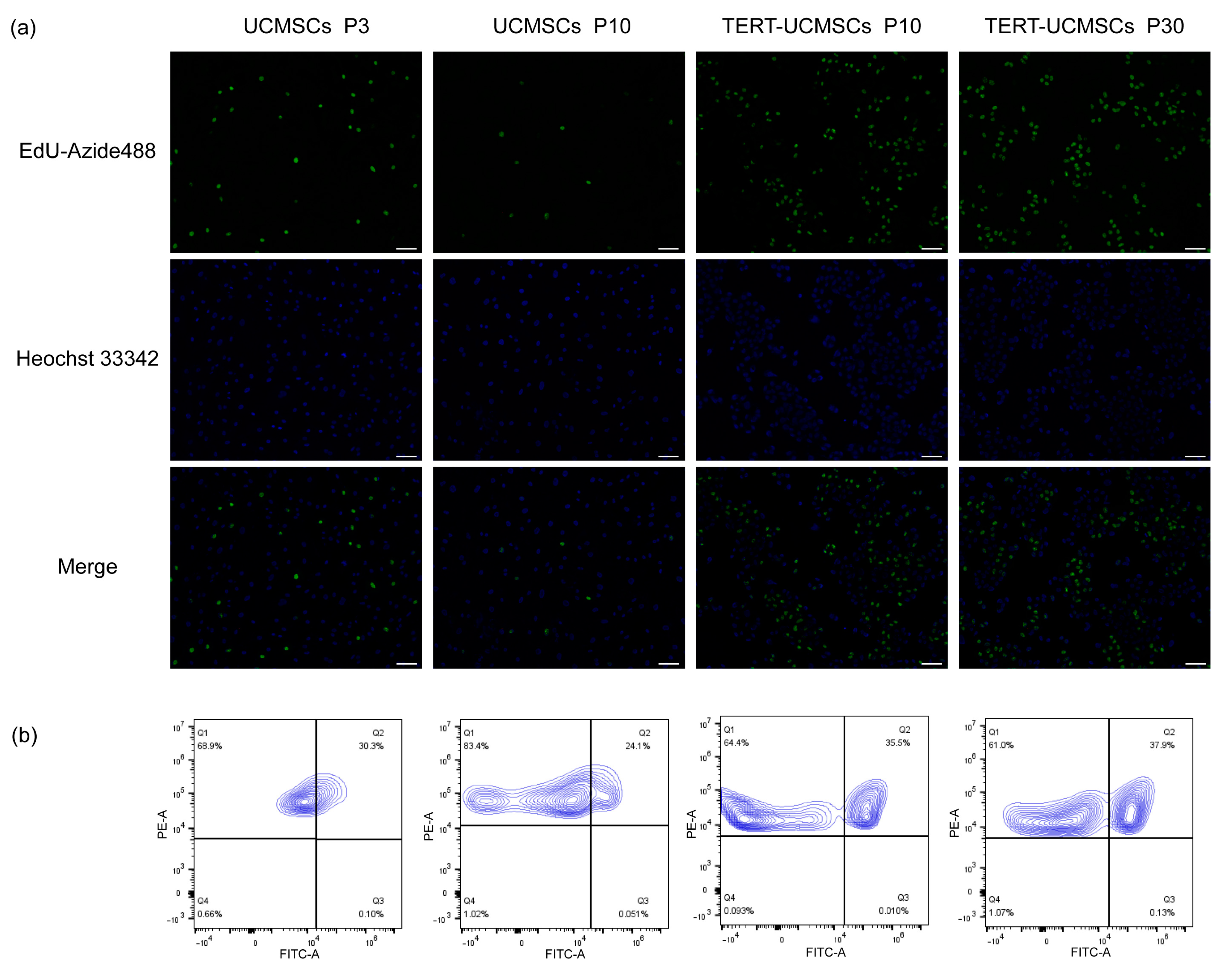
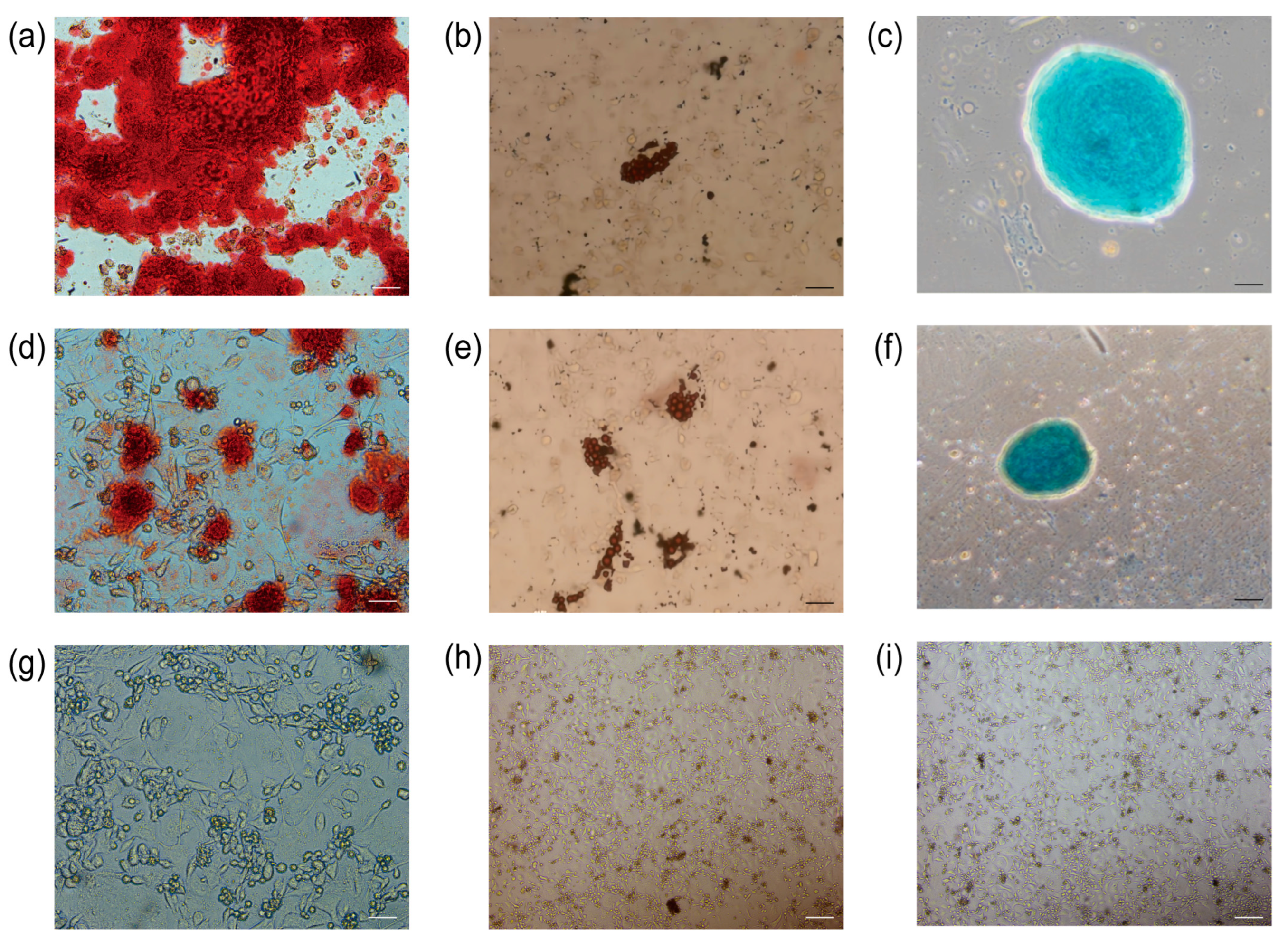
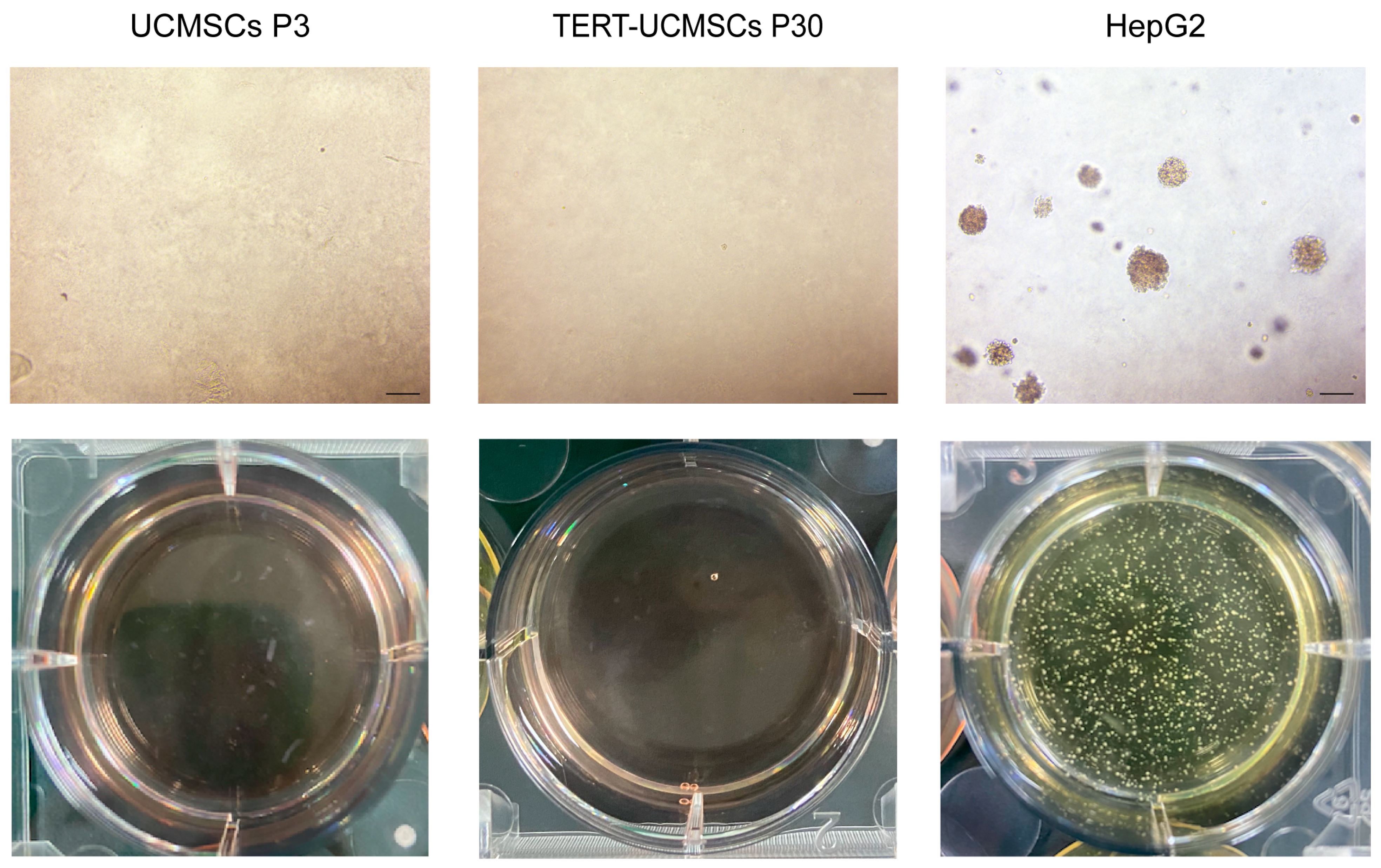
| Gene | Primer Sequence (5′–3′) | Length (bp) |
|---|---|---|
| Homo sapiens TERT | Forward: CAGGAGCTCACGTGGAAGAT Reverse: GTAGGCGCCCATCAGCC | 141 |
| GAPDH | Forward: GGCGTGAACCACGAGAAGTATAA Reverse: CCCTCCACGATGCCAAAGT | 119 |
| Cell Passage Times | FITC | Markers (%) | ||||
|---|---|---|---|---|---|---|
| CD14 | CD34 | CD44 | CD45 | CD105 | ||
| UCMSCs P3 | + | 0.67 | 4.39 | 99.31 | 9.64 | 98.60 |
| − | 99.33 | 95.61 | 0.69 | 90.36 | 1.40 | |
| UCMSCs P10 | + | 0.44 | 1.65 | 97.51 | 0.40 | 99.14 |
| − | 99.56 | 98.35 | 2.49 | 99.60 | 0.86 | |
| TERT-UCMSCs P10 | + | 0.25 | 0.20 | 99.68 | 0.51 | 99.56 |
| − | 99.75 | 99.80 | 0.32 | 99.49 | 0.44 | |
| TERT-UCMSCs P20 | + | 0.12 | 0.13 | 99.45 | 0.92 | 99.33 |
| − | 99.88 | 99.87 | 0.55 | 99.08 | 0.67 | |
| TERT-UCMSCs P30 | + | 0.15 | 0.40 | 98.44 | 1.09 | 99.73 |
| − | 99.85 | 99.60 | 1.56 | 98.9 | 0.27 | |
Disclaimer/Publisher’s Note: The statements, opinions and data contained in all publications are solely those of the individual author(s) and contributor(s) and not of MDPI and/or the editor(s). MDPI and/or the editor(s) disclaim responsibility for any injury to people or property resulting from any ideas, methods, instructions or products referred to in the content. |
© 2024 by the authors. Licensee MDPI, Basel, Switzerland. This article is an open access article distributed under the terms and conditions of the Creative Commons Attribution (CC BY) license (https://creativecommons.org/licenses/by/4.0/).
Share and Cite
Yang, J.; Dong, Y.; Hu, L.; Wang, W.; Li, Y.; Wang, S.; Wang, C. Immortalization of Mesenchymal Stem Cell Lines from Sheep Umbilical Cord Tissue. Biology 2024, 13, 551. https://doi.org/10.3390/biology13070551
Yang J, Dong Y, Hu L, Wang W, Li Y, Wang S, Wang C. Immortalization of Mesenchymal Stem Cell Lines from Sheep Umbilical Cord Tissue. Biology. 2024; 13(7):551. https://doi.org/10.3390/biology13070551
Chicago/Turabian StyleYang, Jinwei, Yitong Dong, Lixinyi Hu, Weihai Wang, Yajun Li, Shujie Wang, and Chunsheng Wang. 2024. "Immortalization of Mesenchymal Stem Cell Lines from Sheep Umbilical Cord Tissue" Biology 13, no. 7: 551. https://doi.org/10.3390/biology13070551
APA StyleYang, J., Dong, Y., Hu, L., Wang, W., Li, Y., Wang, S., & Wang, C. (2024). Immortalization of Mesenchymal Stem Cell Lines from Sheep Umbilical Cord Tissue. Biology, 13(7), 551. https://doi.org/10.3390/biology13070551






